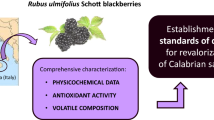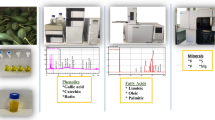Abstract
This study reports the utilization of ball-milled achenes in fermentation to increase the levels of ellagic acid and total phenol content, as well as to enhance the antioxidant capacity of strawberry wine. Achenes were micronized using ball-milling process, and then added to strawberry must prior to fermentation. The effects of the addition of ball-milled achenes on the ellagic acid and total phenol content in strawberry wine were determined, and the free radical scavenging and iron chelation activities were also analyzed. Quality attributes and acceptance were studied in comparison with a leading commercial strawberry wine for market application. The particle sizes of achenes were reduced from 1.1 mm to 400 nm after 30 min of ball-milling, and this led to an increase in the amount of extracted ellagic acid from 550.72 to 915.24 μg/g. The addition of ball-milled achenes to must led to a 19.72 % and 52.37 % increase in ellagic acid and total phenol content in strawberry wine, respectively. The increase in bioactive compounds resulted in increases of 54.09 %, 51.49 % and 56.97 % in ABTS and DPPH radical scavenging, and ferrous ion chelating activities, respectively. Although the commercial strawberry wine showed greater aroma intensity, no significant differences in overall quality and acceptance among the conventional process, added ball-milled achenes and the leading commercial strawberry wines were found. This study demonstrates that supplementation of ball-milled achenes in fermentation can be beneficial in increasing the levels of bioactive compounds and antioxidative capacity, indicating a good market potential.






Similar content being viewed by others
References
Aaby K, Skrede G, Wrolstad RE (2005) Phenolic composition and antioxidant activities in flesh and achenes of strawberries (Fragaria ananassa). J Agric Food Chem 53:4032–4040
Aaby K, Ekeberg D, Skrede G (2007a) Characterization of phenolic compounds in strawberry (Fragario x ananassa) fruits by different HPLC detectors and contribution of individual compounds to total antioxidant capacity. J Agric Food Chem 55:4395–4406
Aaby K, Wrolstad RE, Ekeberg D, Skrede G (2007b) Polyphenol composition and antioxidant activity in strawberry purees, impact of achene level and storage. J Agric Food Chem 55:5156–5166
Aguilera-Carbo A, Augur C, Prado-Barragan LA, Favela-Torres E, Aguilar CN (2008) Microbial production of ellagic acid and biodegradation of ellagitannins. Appl Microbiol Biotechnol 78:189–199
Aguilera-Carbo A, Hernandez-Rivera JS, Augur C, Prado-Barragan LA, Favela-Torres E, Aguilar CN (2009) Ellagic acid production from biodegradation of creosote bush ellagitannins by Aspergillus niger in solid state culture. Food Bioprocess Technol 22:208–212
American Wine Society (2014) AWS Wine Evaluation Chart. American Wine Society, Englewood, OH. http://c.ymcdn.com/sites/www.americanwinesociety.org/resource/resmgr/imported/AWS%20Wine%20Evaluation%20chart%202012.pdf. Accessed 15 July 2014
AOAC (2007) Official methods of analysis, 18th edn. Association of Official Analytical Chemists, Washington DC
Ariza MT, Soria C, Medina JJ, Martinez-Ferri E (2010) Fruit misshapen in strawberry cultivars (Fragaria x ananassa) is related to achenes functionality. Ann Appl Biol 158:130–138
Ayala-Zavala JF, Wang SY, Wang CY, Gonzalez-Aguilar GA (2004) Effect of storage temperature on antioxidant capacity and aroma compounds in strawberry fruit. LWT- Food Sci Technol 37:687–695
Bakkalbasi E, Mentes O, Artik N (2009) Food ellagitannins–occurrence, effects of processing and storage. Crit Rev Food Sci Nutr 49:283–298
Buaban B, Inoue H, Yano S, Tanapongpipat S, Ruanglek V, Champreda V, Pichyangkura R, Rengpipat S, Eurwilaichitr L (2010) Bioethanol production from ball milled bagasse using an on-site produced fungal enzyme cocktail and xylose-fermenting Pichia stipitis. J Biosci Bioeng 110:18–25
Chau CF, Wen YL, Wang YT (2006) Effects of micronization on the characteristics and physicochemical properties of insoluble fibers. J Sci Food Agric 86:2380–2386
Cheel J, Theoduloz C, Rodriguez JA, Caligari PDS, Schmeda-Hirschmann G (2007) Free radical scavenging activity and phenolic content in achenes and thalamus from Fragaria chiloensis ssp. chiloensis, F. vesca and F. x ananassa cv. Chandler. Food Chem 102:36–44
da Silva Pinto M, Lajolo FM, Genovese MI (2008) Bioactive compounds and quantification of total ellagic acid in strawberries (Fragaria x ananassa Duch.). Food Chem 107:1629–1635
Decker EA, Welch B (1990) Role of ferritin as a lipid oxidation catalyst in muscle food. J Agric Food Chem 38:674–678
Dey G, Negi B, Gandhi A (2009) Can fruit wines be considered as functional food? An overview. Nat Prod Rad 8:314–322
Gambacorta G, Antonacci D, Pati S, La Gatta M, Faccia M, Coletta A, La Notte E (2011) Influence of winemaking technologies on phenolic composition of Italian red wines. Eur Food Res Technol 233:1057–1066
Garcia-Estevez I, Escribano-Bailon MT, Rivas-Gonzalo JC, Alcalde-Eon C (2010) Development of a fractionation method for the detection and identification of oak ellagitannins in red wines. Anal Chim Acta 660:171–176
Hakkinen SH, Karenlampi SO, Mykkanen HM, Heinonen IM, Torronen AR (2000) Ellagic acid content in berries: influence of domestic processing and storage. Eur Food Res Technol 212:75–80
Hannum SM (2004) Potential impact of strawberries on human health: a review of the science. Crit Rev Food Sci Nutr 44:1–17
Heninonen IM, Lehtonen PJ, Hopia AI (1998) Antioxidant activity of berry and fruit wines and liquors. J Agric Food Chem 46:25–31
Jeong JH, Jung H, Lee SR, Lee HJ, Hwang KT, Kim TY (2010) Anti-oxidant, anti-proliferative and anti-inflammatory activities of the extracts from black raspberry fruits and wine. Food Chem 123:338–344
Johnson MH, de Mejia EG (2012) Comparison of chemical composition and antioxidant capacity of commercially available blueberry and blackberry wines in Illinois. J Food Sci 71:C141–C148
Jun HI, Song GS, Yang EI, Youn Y, Kim YS (2012) Antioxidant activities and phenolic compounds of pigmented rice bran extract. J Food Sci 77:c759–c764
Kelebek H, Selli S (2014) Identification of phenolic compositions and the antioxidant capacity of mandarin juices and wines. J Food Sci Technol 51:1094–1101
Klopotek Y, Otto K, Bohm V (2005) Processing strawberries to different procedures alters contents of vitamin C, total phenolics, total anthocyanins, and antioxidant capacity. J Agric Food Chem 53:5640–5646
Landete JM (2011) Ellagitannins, ellagic acid and their derivatives metabolites: a review about source, metabolism, functions and health. Food Res Int 44:1150–1160
Negi B, Kaur R, Dey G (2013) Protective effects of a novel sea buckthorn wine on oxidative stress and hypercholesterolemia. Food Funct 4:240–248
Noller J, Wilson B (2009) Markets for tropical fruit wine products. https://rirdc.infoservices.com.au/downloads/09-033 Accessed 15 July 2014
Parley A, Vanhanen L, Heatherbell D (2001) Effect of pre-fermentation enzyme maceration on extraction and color stability in pinot noir wine. Aust J Grape Wine Res 7:146–152
Sariburun E, Sahin S, Demir C, Turkben C, Uylaser V (2010) Phenolic content and antioxidant activity of raspberry and blackberry cultivars. J Food Sci 75:c328–c335
Shi B, Qiang H, Kai Y, Huang W, Quin L (2005) Production of ellagic acid from degradation of valonea tannins by Aspergillus niger and candida utilis. J Chem Technol Biotechnol 80:1154–1159
Sims CA, Bates RP (1994) Effects of skin fermentation time on the phenols, anthocyanins, ellagic acid sediments, and sensory characteristics of a red Vitis rotundifolia wine. Am J Enol Vitic 45:56–62
Wang CCR, Ciou JY, Chiang PY (2009) Effect of micronization on functional properties of the water caltrop (Trapa taiwanensis Nakai) pericarp. Food Chem 113:970–974
Yoo KM, Al-Farsi M, Lee H, Yoon H, Lee CY (2010) Antiproliferative effects of cherry juice and wine in Chinese hamster lung fibroblast cells and their phenolic constituents and antioxidant activities. Food Chem 123:734–738
Acknowledgments
The authors gratefully acknowledge the Dahu Farmers Association for supplying strawberry samples, and special thanks go to Dr. Hsuen-Err Chen for advice and technical assistance.
Author information
Authors and Affiliations
Corresponding author
Additional information
Highlights• Ball-milled achenes was used in must during fermentation to increase the levels of phenolic compounds and bioactivities in strawberry wine.
• A 30-min ball milling of achenes effectively led to an increase in extracted ellagic acid and total phenolic compounds.
• Significant increase in antioxidant capacity in the strawberry wine was found in the presence of ball-milled achenes.
• The addition of ball-milled achenes in must did not cause quality loss in organoleptic properties of strawberry wine.
Rights and permissions
About this article
Cite this article
Lee, PJ., Chen, S. Effect of adding ball-milled achenes to must on bioactive compounds and antioxidant activities in fruit wine. J Food Sci Technol 53, 1551–1560 (2016). https://doi.org/10.1007/s13197-015-2073-z
Revised:
Accepted:
Published:
Issue Date:
DOI: https://doi.org/10.1007/s13197-015-2073-z




